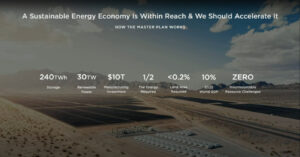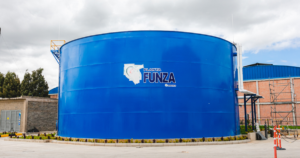The Carbon Removal Alliance, a nonprofit that aims to scale the market for high-quality carbon removal technologies by advocating strong federal policy, launched in February with more than two dozen members. The roster includes ocean carbon sequester pioneer Running Tide, and direct air capture startups Mission Zero and Climeworks, bio-oil sequester Charm Industrial and tree hackers Living Carbon , all of which have become household names if you’re in the carbon removal world. The Alliance includes buyer Stripe, whose head of climate Nan Ransohoff severs as the Alliance’s president.
The group is spearheaded by executive director Giana Amador, previously a co-founder and managing director of the NGO Carbon180. Amador has seen carbon removal grow from a few research projects to an entire industry and believes it needs lobbyists too. The Carbon Removal Alliance wants to work with the government to set up a regulatory and economic system that will allow the infant sector to thrive, grow and be successful both at removing carbon and making money.
Its members embrace a set of five principles to ensure the carbon removals are high quality:
- Permanent storage of the carbon for at least 1,000 years
- Robust additionality — that the removals wouldn’t have happened without outside investment
- Net negativity — that the carbon removal technology removes more CO2 than it causes in residual emissions
- Strong verifiability — that the claims of removal can be validated to be real
- Maximizing co-benefits — that the projects deliver other positives to ecosystems and communities besides the CO2 removal
I sat down with Amador to understand more about the alliance, its priorities and what makes it unique. This conversation has been edited for length and clarity.
Jesse Klein: Why does an organization like this need to exist? What can it do that companies can’t do on their own?

![]()
![]()
![]()
![]()
![]()
![]()
![]()
Giana Amador: One of the things that’s unique about carbon removal is that the number of solutions is pretty broad. There are carbon removal solutions that span across a number of different categories — direct air capture, biomass, carbon removal and storage, enhanced rock weathering, mineralization and storage applications as well as ocean-based approaches. What’s important about bringing all those companies together under one organization is finding the commonalities in the needs across all of their companies.
Klein: What are the first priorities for the Carbon Removal Alliance?
Amador: Education is really important. So far, the historic funding that the carbon removal industry has received has been really focused on one technology, direct air capture. And I think in order to get to that next generation of funding — and to get to that next generation of policies — we really need to do a lot of education around the full suite of carbon removal solutions and how they can play a role in getting us to our climate targets. On the policy side, we’re really focused on working with the Department of Energy as [it is] implementing some of the recent funding [it has] received, both from the Bipartisan Infrastructure Law and the Inflation Reduction Act.
Klein: How are you working with buyers and sellers of removals?
Amador: We have two categories of membership. One is for the carbon removal technology developers and the other is for carbon removal purchasers. The goal is to work with companies who have begun shaping the market on the buyer side to understand the challenges they’re facing as they’re trying to make these carbon removal purchases. It tells us: What are the roadblocks they are facing that we could unlock for a broader suite of companies? And then how do we use that information to help inform markets that the government might create?
One of the core barriers we hear is around monitoring, reporting and verification to ensure high-quality carbon removal. Because there’s no standard that exists today, basically every company purchasing carbon removal is creating a bespoke set of guidelines that it then releases with its request for proposal. And that’s just not something that is scalable. That experience has really informed our policy recommendations around what can the federal government do in terms of setting standards for monitoring, reporting and verification that have catalytic impacts in the field.
Klein: What do you think the carbon removal market needs to scale to make a true impact?
Amador: CRA was founded under this idea that policy can jump-start the industry and can really create a robust market for the full portfolio of carbon removal solutions. In our book, that means federal investments in research, development and demonstration, deployment centers, as well as standards and regulation.
Alongside drastic and rapid emissions reductions, carbon removal is a really important lever we can use to clean up our historic or legacy emissions.
All of those things together can really help bring the carbon removal industry to scale. The U.S. federal government has a really long history of developing and deploying technologies. We have a playbook that we can use to really bring these solutions to scale. We like to refer to carbon removal as solar in the 1970s, where costs were very high and it was deployed in very niche applications. And that’s where we are with the carbon removal field. There’s a lot of potential around the technologies being developed today.
Klein: What about the skepticisms of carbon removal as a significant innovation for mitigating climate change? That we should be focusing on reducing emissions.
Amador: There’s a lot of work that the carbon removal industry can do to just define the role that carbon removal plays in the broader climate fight. And I think it’s really important for us to make clear that carbon removal is not an excuse for continuing to emit carbon dioxide. But alongside drastic and rapid emissions reductions, carbon removal is a really important lever we can use to clean up our historic or legacy emissions. And that is a really important invaluable tool in our toolkit.
Klein: How do you feel about the corporate offset market acting as the main tool for funding carbon removals as it does currently?
Amador: I’m concerned about conflating carbon removal with carbon offsets. Most credits are sold on a marketplace that doesn’t ensure quality in the long run. So I think in the near term, the carbon offset market might be an opportunity for some of these solutions to get first customers, but I think in the long run, we need to look towards other funding mechanisms.
Klein: Like what?
Amador: I think we could think of federal procurement as an opportunity for scaling carbon removal in the long run. I think the federal government pays for a lot of essential cleanup services like waste management. And we could see the federal government essentially procuring carbon removal services as a public good and a service to our own national climate commitments.
We could think about carbon removal commitments that are separated from company emissions reduction goals. A lot of the companies actually aren’t counting carbon removal onto their climate ledger. They’re not using it to offset emissions. They’re just purchasing carbon removal as a way to catalyze the industry.
- SEO Powered Content & PR Distribution. Get Amplified Today.
- PlatoData.Network Vertical Generative Ai. Empower Yourself. Access Here.
- PlatoAiStream. Web3 Intelligence. Knowledge Amplified. Access Here.
- PlatoESG. Automotive / EVs, Carbon, CleanTech, Energy, Environment, Solar, Waste Management. Access Here.
- PlatoHealth. Biotech and Clinical Trials Intelligence. Access Here.
- ChartPrime. Elevate your Trading Game with ChartPrime. Access Here.
- BlockOffsets. Modernizing Environmental Offset Ownership. Access Here.
- Source: https://www.greenbiz.com/article/how-new-industry-alliance-hopes-scale-market-carbon-removals
- :has
- :is
- :not
- :where
- $UP
- 000
- 1
- 15%
- 7
- a
- About
- across
- Act
- acting
- actually
- advocating
- aims
- AIR
- All
- Alliance
- allow
- alongside
- amador
- an
- and
- applications
- approaches
- ARE
- around
- AS
- At
- barriers
- Basically
- BE
- because
- become
- been
- begun
- being
- believes
- besides
- bespoke
- biomass
- bipartisan
- book
- both
- bring
- Bringing
- broad
- broader
- but
- BUYER..
- buyers
- by
- CAN
- capture
- carbon
- carbon dioxide
- Carbon Offsets
- catalyze
- categories
- causes
- Center
- Centers
- challenges
- change
- claims
- clarity
- clear
- click
- Climate
- Climate change
- Co-founder
- co2
- commitments
- Communities
- Companies
- company
- concerned
- continuing
- Conversation
- Core
- Corporate
- Costs
- could
- counting
- CRA
- create
- Creating
- Credits
- Currently
- Customers
- data
- deliver
- Department
- Department of Energy
- deployed
- deploying
- deployment
- developed
- developers
- developing
- Development
- different
- direct
- Director
- do
- does
- doesn
- down
- dozen
- Economic
- economic system
- Ecosystems
- Education
- embrace
- Emissions
- energy
- enhanced
- ensure
- Entire
- essential
- essentially
- Every
- executive
- Executive Director
- exist
- exists
- experience
- facing
- far
- February
- Federal
- Federal government
- feel
- few
- field
- fight
- finding
- First
- five
- focused
- focusing
- For
- Founded
- from
- full
- funding
- generation
- get
- getting
- goal
- Goals
- good
- Government
- Group
- Grow
- guidelines
- hackers
- happened
- Have
- head
- hear
- help
- High
- high-quality
- historic
- history
- hopes
- household
- How
- HTTPS
- i
- idea
- if
- image
- Impact
- Impacts
- implementing
- important
- in
- includes
- industry
- inflation
- inform
- information
- informed
- Infrastructure
- Innovation
- invaluable
- Investments
- IT
- ITS
- jpg
- just
- launched
- Law
- least
- Ledger
- Legacy
- Length
- like
- lobbyists
- Long
- Look
- Lot
- Main
- make
- MAKES
- Making
- management
- managing
- Managing Director
- Market
- marketplace
- Markets
- means
- mechanisms
- Members
- membership
- might
- mitigating
- money
- monitoring
- more
- most
- move
- names
- National
- Near
- Need
- needs
- New
- next
- Ngo
- niche
- no
- Nonprofit
- number
- ocean
- of
- offset
- offsets
- on
- ONE
- Opportunity
- or
- order
- organization
- Other
- our
- outside
- own
- pays
- pioneer
- plato
- Plato Data Intelligence
- PlatoData
- Play
- plays
- policies
- policy
- portfolio
- potential
- presentation
- president
- pretty
- previously
- principles
- procurement
- projects
- proposal
- public
- purchases
- purchasing
- quality
- rapid
- RE
- really
- received
- recent
- Recent Funding
- recommendations
- reducing
- reducing emissions
- reduction
- reductions
- Regulation
- regulatory
- Releases
- removal
- removing
- Reporting
- request
- research
- roadblocks
- robust
- Rock
- Role
- roster
- Run
- s
- scalable
- Scale
- scaling
- sector
- see
- seen
- Sellers
- service
- Services
- set
- setting
- shaping
- should
- side
- significant
- So
- so Far
- solar
- sold
- Solutions
- some
- something
- span
- spearheaded
- standard
- standards
- Startups
- storage
- stripe
- strong
- successful
- suite
- system
- T
- targets
- Technologies
- Technology
- tells
- term
- terms
- than
- that
- The
- The Projects
- their
- then
- There.
- These
- they
- things
- think
- this
- those
- Thrive
- to
- today
- together
- too
- tool
- toolkit
- towards
- tree
- true
- two
- u.s.
- under
- understand
- unique
- unlock
- us
- use
- using
- validated
- Verification
- very
- wants
- was
- Waste
- Way..
- we
- WELL
- were
- What
- which
- WHO
- whose
- why
- will
- with
- without
- Work
- working
- world
- you
- zephyrnet








